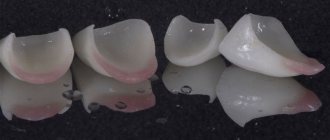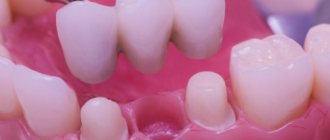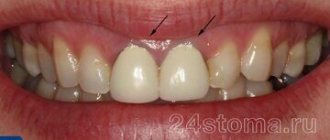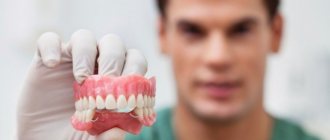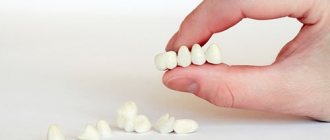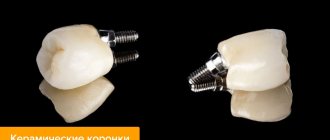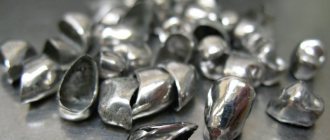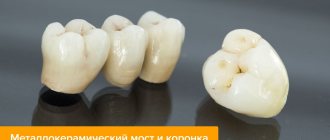Not everyone manages to keep their teeth intact throughout their lives. When teeth are lost, the patient loses the ability to smile beautifully, and he experiences disturbances in speech and chewing functions. Orthopedic dentistry is designed to solve these problems. Restoration of the structure and functions of the masticatory apparatus occurs through the installation of orthopedic structures. Modern designs for prosthetics completely replace lost teeth. They are adaptive, hypoallergenic, and have a long service life.
Indications for installation of a prosthesis
The general indication for prosthetics is damage or absence of a certain number of dental units. Dental defects lead to ineffective chewing of food. The bite is disturbed, the aesthetics of the smile suffers. The most common indications for prosthetics are the following disorders:
- Adentia (complete or partial loss of teeth). Restoration of the dentition is carried out by removable prosthetics or implantation of dental units.
- Complete or partial destruction of the coronal part of the tooth, in which filling is impractical. When preserving the root, a pin structure or stump tab is used.
- Pathological abrasion of enamel, which is a systematic violation of the enamel layer of dental units. The loss of hard dental tissues leads to malocclusion.
- Traumatic damage to teeth. The patient may be offered various options for restoring the dentition, depending on the severity of the situation.
- Pathology of the alveolar process leading to serious malocclusion. A frequent consequence of partial edentia, leading to the restructuring of the alveoli and a decrease in the functionality of the dentition.
- Single and multiple dental defects. The patient can be offered various design options depending on the existing problems.
Installing a crown on a tooth
The process of installing a crown on a tooth is strictly regulated. It is carried out in stages. The appearance, functionality and lifespan of the prosthesis depend on how the crown is placed on the tooth and how carefully the work is done.
Inspection
Installing a crown on a tooth begins with an examination by an orthopedic dentist. He examines the oral cavity and, if necessary, prescribes x-rays. Based on the results of the inspection and examination, preparatory measures are carried out.
Treatment
A complete sanitation of the oral cavity is carried out. Treatment includes caries, gum and oral cavity diseases. In severely damaged units, the pulp is removed and the root canals are cleaned (depulpization). Professional dental cleaning is required. Only after the doctor is convinced of the complete absence of foci of infection can prosthetics be performed.
Turning
It is not easy to crown a tooth. To install a crown on a tooth, it needs to be ground - remove the surface layer of hard tissue with a thickness equal to the thickness of the future prosthesis. Structures can be made of different materials and have different thicknesses, so turning will also be carried out to different depths.
Grinding a pulpless tooth before installing a crown is painless. It is recommended to grind a living, non-pulpless tooth under local anesthesia.
Taking an impression and making a model
An impression or impression is taken from a unit that is fully prepared for prosthetics, reflecting the condition of the prosthetic part of the dentition. For this purpose, an elastic dental material is used that retains its shape for a long time (silicone mass, dental wax, plaster).
The oral cavity is dried, the material selected for making an impression is placed in a special mold (spoon), and it is applied to the place of prosthetics in the dentition. The patient can only clench his jaws and keep them clenched for several minutes until the impression hardens. The resulting impression is washed under running water, placed in a special solution and sent to a dental laboratory. Using the cast, a plaster model is first made, it is tried on, and then a prosthesis is made from the selected material.
Fixation of crowns
The installation of the crown ends with its strengthening - fixation. First, the crown is strengthened with a temporary compound. The patient wears the prosthesis, assessing the degree of comfort, for 2 to 4 weeks. If everything is normal, the temporary fixation is replaced with a permanent one, strengthening the prosthesis with cement. If the prosthetic unit has enough natural tissue, then the prosthesis is placed directly on the treated and filled tooth. If there is not enough tissue, the prosthesis can be fixed on an inlay, a pin or an implant (titanium root).
On the tab
Fixation of the crown on the core tab
This is the best option for prosthetics. The inlay is made in the laboratory from an impression and reliably covers the damaged tooth. Even if the crown is destroyed for some reason, the inlay will not be damaged and re-prosthetics can be carried out easily. A prosthesis on an inlay can last a very long time, from 7 to 10 years or more, depending on the material of manufacture.
On the pin
Crown on pin
The orthopedist decides which crown is best to install on the chewing tooth and how to strengthen it, but most experts believe that a supporting structure in the form of a pin is most suitable. The pin is inserted into the preserved tooth root when there is significant destruction (at least half) of the crown. Before this, treatment and removal of pulp from the root canals is carried out. Contraindications for the installation of a pin are any inflammatory processes, including pulpitis and periodontitis, split roots, narrow curved root canals.
Pins are placed mainly on the lateral (chewing) teeth, but sometimes on the front teeth. The price depends on the material of manufacture. Cheaper metal ones with threads (anchors) are placed mainly on chewing teeth. More modern fiberglass ones are transparent, without threads, installed on cement.
On an implant
Crown on an implant
An implant is a titanium root that is implanted into the jawbone. Installed when the root is destroyed, on which it is impossible to install a pin. Dental implantation can take place immediately after removal of the natural root (single-stage technology) or after some time (delayed).
An adapter (abutment) is installed on top of the titanium root, onto which the prosthesis is attached. The abutment can be metal and then it will be visible through transparent metal-free crowns. Zirconium abutments can be placed on any teeth, metal ones - mainly on the lateral ones. Usually, a temporary structure is first installed, and after the implant has healed, it is changed to a permanent one.
Types of prostheses
Modern orthodontics offers many types of dental restoration. Each method has its own advantages and disadvantages and is used to solve a particular problem. The type of prosthesis and method of prosthetics are selected by the attending physician together with the patient, based on the clinical situation, budgetary capabilities and patient preferences. Orthopedic structures are distinguished by the method of fixation, the material of manufacture, the defect being replaced, and the type of fastenings in the oral cavity.
Classification by method of fixation
Based on the method of fixation, a distinction is made between removable and non-removable structures. A very special type is fixed dentures on implants.
- Removable structures. They can be removed from the mouth independently. They solve the problem of the absence of one or more units in the dentition. Inexpensive and easy to care for.
- Fixed structures are permanently fixed in the oral cavity. They are durable, strong and efficient. They have a higher cost.
- Implantation is the most complex and expensive type of prosthetics. Implants are a multi-component structure that is inserted into the bone tissue of the jaw and replaces the root part of the teeth. On their basis, the restoration of the dentition is carried out.
Classification by material of manufacture
In modern dentistry, many materials have been developed for the manufacture of prosthetic structures. Here are the four main types:
- Plastic structures are made from polymerized acrylic. This lightweight and durable material is inexpensive and available. The lightweight porous structure ensures a tight fit, which significantly reduces the adaptation time. Under heavy loads, plastic prostheses are prone to loosening and are therefore short-lived. Used for temporary use.
- Nylon prostheses are made from soft, hypoallergenic synthetic material. They are secured in the mouth using special clasps. The disadvantage is its short service life. The chewing load is distributed unevenly, which can lead to bite problems.
- Zirconium dioxide structures. Zirconium dioxide is a durable natural mineral, naturally enriched without the presence of synthetic impurities. Used for the preparation of fixed dentures. It has many advantages: it holds the chewing load well, its shade is close to natural enamel, and it has low thermal conductivity. Zirconium dentures are not used to treat severe malocclusions, since a strong crown begins to destroy neighboring teeth.
- Ceramic dentures are made from specially treated ceramics with the addition of lithium disilicate. The crown material is very durable and reliable, its structure is closest to tooth enamel. Ceramic dentures have the highest aesthetics, therefore they are used for prosthetics in the smile area.
Classification of dentures according to the volume of the replacement defect
Depending on the clinical situation, the patient may be indicated for a complete or partial denture:
- Complete dentures are removable or conditionally removable structures used in the absence of all units in the dentition. A complete denture simulates the entire dentition. The base of the prosthesis rests on the gums and helps fix the structure in the oral cavity.
- Partial dentures help restore dentition when several teeth are missing. They imitate a fragment of the dentition, replacing several nearby missing dental units or teeth lost in different parts of the jaw.
Classification of prostheses by type of fastenings
Depending on the method of fastening the prosthesis in the oral cavity, the functional load on the supporting tissues is distributed differently. The following types of orthopedic structures are distinguished:
- Lamellar dentures are a type of removable structures. Effective for partial or complete edentia. They differ in the material of manufacture and the method of attachment in the oral cavity. Attached directly to the mucous membrane.
- Bridges are non-removable structures used in cases where several dental units are missing in a row. They are attached to dental units spaced apart from each other and ground for crowns.
- Supported or clasp dentures are distinguished by a special way of transferring the load: through the supporting teeth, periodontium and mucous membrane. This method is called semi-physiological.
Types of crowns for teeth
Since dental crowns are designed for different purposes, they can be made from different materials. The orthopedist decides which crowns are best to put on the teeth in a particular case. Based on the material of manufacture, the following types of dental crowns are distinguished: metal, plastic, ceramic, metal-ceramics, glass-ceramics, zirconium dioxide, metal-plastic.
Plastic crowns for teeth
Temporary plastic crowns
Plastic (mostly acrylic) is a short-lived material, so currently a plastic crown on a tooth is mainly a temporary structure. These types of dental crowns have the following advantages:
- temporarily restore appearance, support chewing and speech functions;
- protect prepared (processed for prosthesis) teeth from pain when exposed to mechanical, chemical and temperature stimuli;
- prevent displacement and loosening of prepared teeth in the absence of their support by neighboring units;
- prevent the development of pulpitis and periodontitis with preserved dental pulp.
Minuses:
- possible burn of the pulp during installation, as well as allergic reactions to acrylic and inflammatory processes of periodontal tissues;
- fragility and breakage (but repair is possible using special glue);
- color change due to food coloring;
- limited validity period (2 years) - this is enough for temporary dentures, but not for permanent ones.
Metal crowns for teeth
Metal alloy crowns
These are the very first materials used to make dentures. Metal crowns on teeth are still in demand today, provided they are used correctly. They are made from alloys of precious and base metals with the addition of nickel, chromium, cobalt and other metals. Models made of gold are also alloys, since gold is a very soft and short-lived material, and the alloy will last for decades, having a beneficial effect on all tissues of the oral cavity. Models made of steel with gold plating are no different in appearance and wearability from gold ones, but do not have a positive effect on the periodontal tissues. If the question arises, which crown is better for a chewing tooth, dentists often recommend metal. Pros of a metal dental crown:
- validity period of at least 10 years; with proper care – decades; rarely break;
- biocompatibility with tissues;
- absence of corrosion in the alloys used;
- tolerate chewing load well;
- reasonable prices.
Minuses:
- not very attractive in appearance, since they differ as much as possible from natural units; therefore, they try to place a crown on a metal tooth on the lateral (chewing) units;
- sometimes they cause allergies and galvanic (electrochemical) reactions (if there is already a tooth made of another alloy in the mouth).
Ceramic crowns for teeth
Ceramic crowns
Ceramic tooth crowns are made from the most fragile material – pressed porcelain without any additions. They have their pros and cons. Pros of a ceramic dental crown:
- very beautiful – the appearance completely corresponds to natural teeth;
- strength;
- validity period - with proper care 10 years or more;
- completely biocompatible with tissues, do not cause allergies or gum irritation;
- do not change color when using food dyes;
- require minor grinding of hard dental tissues.
Minuses:
- fragile, breakages in the form of chips are more common than other materials;
- cannot withstand high chewing loads, so these crowns are placed on the front teeth;
- high price.
Zirconium dioxide dental crowns
Zirconium crowns
Zirconium crowns are made from the mineral zircon (silicon acid) through special processing using additives. The result is a very hard, durable material that also has the necessary plastic properties so that it can be used to make a denture. Zirconium crowns are made either from zirconium alone or by covering it with ceramics. The latter look more beautiful, so they cost more. Pros of a zirconium dental crown:
- the most durable material, service life - 15 years or more;
- zirconium crowns are beautiful - metal-free ceramics based on zirconium dioxide give a good aesthetic effect, but pure zirconium prostheses also look good;
- the possibility of manufacturing a structure for both anterior and lateral (chewing) units;
- completely biocompatible with human tissues, do not cause allergies or irritation.
Minuses:
- increased wear of teeth on the opposite side is possible;
- the top layer of ceramics may chip;
- high price.
Metal-ceramic crowns on teeth
Metal-ceramic tooth crowns have a metal alloy frame, which ensures the strength of the prosthesis, and a ceramic coating, which creates an aesthetic appearance. Advantages of a metal-ceramic dental crown:
- quite durable - service life is about 8 - 10 years;
- aesthetic appearance;
- cheaper than metal-free ceramics;
- if the frame is made of gold or platinum, then the prosthesis does not cause tissue irritation or allergies.
Minuses:
- metal-ceramic tooth crowns are not as beautiful as those made from porcelain or zirconium;
- chips of ceramics may appear;
- sometimes they darken, acquiring a grayish tint;
- frames made of base metals sometimes cause tissue irritation and allergies.
Glass-ceramic dental crowns
Glass-ceramic crowns
One of the most modern dental materials, combining high aesthetic qualities and sufficient strength. This type of dental crown is made on the basis of glass and ceramics using lithium disilicate (Empress Esthetic), lithium disilicate (E-max), zirconium silicate (Ceramage), etc. Advantages of a glass-ceramic dental crown:
- thin, therefore allowing for minimal tooth treatment;
- smooth surface and good adhesion to natural hard dental tissues - reduces the risk of developing caries;
- transparency and aesthetics - outwardly no different from the enamel of natural teeth;
- Lightweight design increases wearing comfort;
- do not change their color throughout use;
- validity period – more than 10 years;
- biocompatibility due to the absence of metal in the frame - does not cause gum irritation or allergic reactions.
Minuses:
- high price;
- hardness – can cause increased wear of teeth located opposite;
- fragility - can crack, repairing it is problematic.
Metal-plastic dental crowns
Metal-plastic crowns
A metal-plastic dental crown has a metal (usually base metal alloy) frame and a plastic covering. Temporary structures are most often made from this dental material, as it is not durable. A metal-plastic dental crown has the following advantages:
- ease of installation and repair of the structure;
- low cost.
Minuses:
- short validity period - about 2 - 3 years;
- allergies and tissue irritation may occur;
- loose fit to natural hard tissues – risk of caries and inflammatory diseases;
- color change due to the use of food coloring.
From the table you can find out which dental crowns are best suited for you:
| View | Aesthetic indicators | Period operation | Compatibility with the body | Allergy |
| Plastic | low | 2 years | not always | often |
| Metal | low | 10 or more years | not always | often |
| Ceramics | high | 10 years | high | No |
| Zirconium dioxide | high when combined with ceramics | 15 or more years | high | No |
| Metal ceramics | average | 10 years | not always | It happens |
| Glass ceramics | high | 10 or more years | high | No |
| Metal-plastic | average | 2 – 3 years | not always | It happens |
How to choose the right dentures
The selection of a denture is made by the attending dentist together with the patient. After the initial examination, the doctor assesses the clinical situation and advises the patient, explaining what type of prosthetics is indicated for him. The patient makes a decision taking into account the doctor’s recommendations and his preferences.
Doctors at the Consilium Dent dental clinic will provide a free initial consultation on the selection and installation of orthopedic structures. After the initial examination, the dentist will select the optimal prosthetic option and advise the patient on how to prepare for prosthetics. He will talk in detail about how to care for the oral cavity during and after prosthetics. When choosing, the number of missing teeth, the condition of the tooth bed and gums, financial capabilities and the desire of the patient are taken into account.
Which crowns are best for teeth?
All types of dental crowns have their own indications and contraindications. Certain types are used on different teeth. Recommendations about which crown is better for the chewing tooth and which for the front tooth are given to the patient by the orthopedist. But, for example, a metal-ceramic crown can be installed on any tooth.
Crowns for front teeth
Incisors and canines are always visible when talking and smiling. In total, each jaw has 4 incisors (2 central and 2 lateral) and 2 canines. Their main function is to bite food, create an aesthetic appearance and maintain correct diction. What crowns are best for such teeth? Most often, ceramics and glass-ceramics are used for crowns on the front teeth. These dental materials allow you to create the maximum aesthetic effect, as well as maintain chewing and speech function.
Crowns for lateral (chewing) teeth
These types include premolars and molars. When smiling, they are not always visible (sometimes 1 premolar is visible) and perform a chewing function. Crowns on chewing teeth are most often installed metal or zirconium. At the patient's request, glass ceramics can also be used. If the first premolars are visible when smiling, ceramics, glass ceramics or zirconium crowns are installed on them.
The final decision on which crown is best suited for a chewing tooth is made by the doctor together with the patient. Plastic or metal-plastic is most often used as a temporary structure.
Removable dentures. What to prefer?
If all or a significant part of the teeth are lost, the patient will be offered the installation of a removable denture. The removable design is a plastic plate that fits tightly to the mucous membrane and follows its shape. This ensures its strong attachment in the oral cavity. Artificial teeth are attached to the plate, imitating the patient’s own lost dental units. There are two types of removable structures: partially removable and completely removable.
The best partially removable designs
Partially removable dentures are used for partial restoration of the dentition. This type of denture is indicated if only part of the teeth are missing. Plastic and nylon are used for manufacturing. Special hooks or special clasps are used as fastening means. The fasteners are quite strong and provide reliable fixation of the dentition.
Main advantages and disadvantages
Partially removable structures are universal and have many advantages:
- The chewing load is evenly distributed, which ensures the safety of the dentition.
- The oral care procedure is simple and easy.
- Durable clasps provide reliable fixation in the oral cavity.
- The prosthesis ensures complete restoration of chewing function.
- Due to the uniform load, deformation of some dental units is excluded.
Among the disadvantages are the following:
- Dentures are quite expensive.
- Not all designs are sufficiently aesthetic, so they are not suitable for restoration of a row in the smile zone.
- Dentures require periodic adjustments.
Removable structures for complete dentures
This type of structure is used for complete restoration of the dentition in cases of total edentia. These are light and durable dentures that are in good contact with the oral mucosa. Typical denture materials used for complete dentures are nylon or acrylic. The fastenings are made in the form of so-called suction cups.
Advantages and disadvantages
Among the advantages, the following should be noted:
- The designs are easy to manufacture, which determines the low price.
- In case of breakdowns or damage, they can be easily restored.
- Cover a significant part of the sky, which makes contact very reliable
- Easy to care and use.
There are also a number of disadvantages:
- The structures wear out quite quickly, since the work of the masticatory muscles is not always coordinated.
- Due to constant pressure, the volume of tissue in the jaw joint gradually decreases. This impairs the retention of the prosthesis, and it may fall out when speaking.
- If the prosthesis is not positioned correctly, pain may occur in the mouth.
Let us compare the removable structure made of acrylic and nylon.
- Acrylic processes are more affordable.
- Acrylic dentures can break over time, while nylon dentures are made of flexible and durable material, so the likelihood of breakage is minimal.
- An acrylic prosthesis does not deform; a nylon prosthesis can change shape.
- Nylon has a smooth structure, does not absorb odors, does not stain, and is non-toxic. Acrylic is a more porous material and is susceptible to staining and staining over time.
- The color of nylon is closer to the shade of natural enamel and looks aesthetically pleasing. Acrylic has a wide range of shades; it is possible to choose an option that is as close as possible to the individual shade of the teeth.
- Nylon constructions are more hypoallergenic than acrylic ones
Removable dentures without palate
Sandwich dentures are designed for partial prosthetics and are an arch made of dense polymer that imitates the jaw arch. They are fixed to the molars that are preserved on both sides of the jaw. The fasteners are telescopic crowns that fit tightly and fix the product.
The advantage of these designs is that they leave the palate and sublingual space free, which ensures the preservation of diction and the natural sensitivity of taste buds. In some patients, such prostheses cause a gag reflex, which can make wearing difficult. Such patients are recommended to opt for the clasp system.
How to insert teeth: methods used today
Everyone is interested in which teeth are best to insert, what materials are used for this, and how long will you have to wait until the dentures or crowns are ready? More inquisitive patients ask: are wisdom teeth prosthetic? It all depends on the specific case. If, for example, you need to insert three teeth – the 5th, 6th and 7th, then the 8th tooth may well become the supporting one. But if only the wisdom tooth itself is lost, then it does not need to be replaced. If a removable prosthesis of chewing teeth is made, then, as a rule, there are no “eights” in it: this is justified, since the amount of work of the dental technician is reduced and, accordingly, the patient’s costs are reduced. The remaining teeth - canines, incisors, molars - are definitely subject to prosthetics.
There are several ways to insert teeth:
- Make a removable denture based on natural or implanted teeth.
- Replace a missing tooth with an implant.
- Place a bridge supported by an implant or natural teeth.
- Install a clasp prosthesis.
- Create a removable denture supported by soft tissue and mucous membrane with complete edentia.
There are also several materials from which crowns and artificial teeth are made. They vary significantly in cost, which allows you to choose prosthetic options for different budgets.
Expert advice
There is no clear answer to the question of which prosthesis to choose in a given case. The structural features of the patient’s jaw apparatus, his age, and the severity of the problem are of great importance. Approximate recommendations are given in the table:
| Situation | Type of prosthetics |
| Clinical picture | Recommended type of prosthetics |
| Availability of dental units suitable for fastening the structure | Conditionally removable prosthesis |
| The dentition lacks a large number of dental units, and the installation of bridge-like structures or implantation is impossible | Removable prosthetics |
| Molars or incisors are completely absent from the dentition | Removable prosthetics. It is recommended to choose acrylic dentures |
| Molars and premolars are missing | Partially removable prosthetics |
| Requires installation of temporary prostheses | Partially removable prosthetics |
Fixed dentures. Which ones to choose?
Fixed prosthetic structures are firmly fixed in the patient’s oral cavity with cementing material and are not intended for self-removal. There are three main types of fixed structures: crowns, bridges, microprostheses.
Crowns
A dental crown is a non-removable orthopedic structure of a natural shape that covers the coronal part of a tooth or a separate area of its surface. Crowns are made from high-quality materials: metal, zirconium, porcelain, ceramics, plastic.
Advantages and disadvantages of crowns
The main advantage of dental crowns is that they are able to completely restore the functionality of the dentition. Other benefits include:
- strength;
- aesthetics;
- low price;
- long service life
Among the disadvantages of structures of this type are:
- metal crowns are not aesthetically pleasing enough, so they are not used in the smile area;
- it is not always possible to choose a design color that fully matches the color of natural enamel;
- in some cases it is necessary to sharpen the tooth.
Bridge structures
A bridge is a type of fixed prosthesis used to replace significant defects in the dentition. A bridge rests on two dental units spaced apart from each other and replaces several destroyed, consecutive dental units.
Advantages and disadvantages of bridges
Bridges are structures that are designed for use in cases of significant defects in the dentition. This quality determines the main advantages of the structures:
- When chewing, the load is evenly distributed, determining the long service life of the prosthesis.
- The use of a bridge helps prevent atrophic processes in bone tissue. They begin due to insufficient load on the jaw in the absence of a significant number of dental units.
- A bridge can ensure normal grinding of food during chewing, and therefore maintain the health of the patient’s digestive system.
The disadvantages of bridges include the following:
- A structure that replaces several dental units is quite expensive.
- Teeth that serve as support have to be ground down and depulped even if they are healthy.
Microprostheses
Microprostheses are microstructures made of ceramic or composite material that serve to restore the damaged part of the tooth surface. These include dental inlays, veneers and lumineers.
Microprosthetics is a gentle technology designed to preserve severely damaged teeth. It allows you to protect the front wall of the tooth and restore the aesthetics of the dentition.
Advantages and disadvantages of microprostheses
The advantages of microprosthetics are obvious:
- A microprosthesis effectively hides defects and strengthens the tooth, which prevents its further destruction.
- An ideally selected shade makes the tooth indistinguishable from other units of the dentition.
- Microprosthetics does not require grinding of teeth.
The disadvantages are:
- Microprosthetics cannot be used for carious teeth.
- The cost of the procedure is quite high.
When choosing the appropriate type of prosthetics, the dentist aims to solve the patient’s problem in the most acceptable way.
| Situation | Type of prosthetics |
| One or more incisors are destroyed | Dental crown made of ceramics |
| Completely missing dental unit | Bridge prosthesis |
| Chipped edges of the tooth | Microprosthetics (veneers) |
| Chewing teeth destroyed | Dental crown. Recommended materials: metal, metal ceramics |
Which prosthesis to choose: removable or fixed?
Knowledge of the advantages and disadvantages of removable and fixed structures will help you choose the optimal type of prosthetics
| Kinds | Advantages | Advantages |
| Fixed structures | High level of reliability | There is a need to grind down adjacent teeth |
| Quick adaptation to the prosthesis and comfortable wearing | Sometimes the mucous membrane rubs when worn, making correction difficult | |
| High aesthetics | While the process of adaptation is underway, changes in diction and taste of food may be observed. | |
| The chewing load is distributed evenly | High cost with good quality material | |
| Easy to care for | When installing metal crowns, a metallic taste in the mouth is possible. | |
| With proper care, a long service life will be ensured. | ||
| Removable structures | Maintenance is simple and easy | Over time, the denture may become dislodged when eating. |
| Low cost | There is a risk of developing stomatitis | |
| The installation procedure is short | In some cases it is necessary to use a fixing paste | |
| Periodontal disease is not an obstacle to installing a prosthesis | When worn, a gag reflex may occur | |
| This type of prosthesis can be manufactured quickly | When worn, the shape of the face may change |
The choice of the type of prosthesis for each patient occurs individually. Dentists recommend paying attention to removable structures for the following problems:
- with complete or partial edentia;
- if there are pathological changes in the periodontium;
- if oral care is not thorough enough;
- if there are terminal defects of the dentition.
- in case of financial difficulties.
Fixed dentures are recommended for choice in the following cases:
- when no more than one or two units are missing in the dentition;
- if there are significant chips in the enamel;
- with pathological abrasion of enamel;
- with yellowed enamel;
- if it is necessary to restore the smile area;
- in the presence of carious teeth.
What are dental crowns
This is an artificial denture that is installed on a pre-treated natural crown. The purpose of prosthetics is to restore the anatomical shape, aesthetic appearance, and chewing function. Crowns can also be part of some other orthopedic structure: support for a partial removable or fixed denture, splinting for loosening of the dentition, etc.
Crowns on teeth
The design must meet certain requirements:
- restore the anatomical shape of the tooth, its aesthetics and color;
- support chewing and speech function;
- fit well to the neck of the destroyed tooth, make correct contact with neighboring units, as well as with teeth on the opposite side, without creating an obstacle to the closure of the dentition;
- do not interfere with the motor activity of the lower jaw;
- do not cause allergic reactions or tissue irritation.
All designs of this type have their pros and cons.
pros
Of all types of dentures, this one has a number of positive qualities, in some cases giving advantages over other types of prosthetics:
- rapid restoration of appearance and chewing function;
- large selection of materials for prosthetics;
- correct distribution of the load, eliminating the risks of abrasion of adjacent teeth and malocclusion;
- prevention of destruction of periodontal tissues and atrophy of jaw bone tissue;
- the ability to install several prostheses at once;
- if the root is partially destroyed, it is possible to install the prosthesis on a pin; if there is a complete absence of a root, it can be installed on an implant (titanium root).
Minuses
Negative qualities:
- the need to grind a tooth, sometimes a healthy one, if it performs a supporting function;
- a short period of discomfort after installation of the prosthesis; with the correct selection of material and compliance with installation technologies - very short;
- allergic reactions to certain dental materials;
- possible complications are reduced to a minimum with proper prosthetics;
- high cost of high-quality materials and insufficiently good appearance of cheap ones.
Popular questions about prosthetics
Here are collected popular questions from patients about prosthetics asked on the site forum. Experienced dentists answer.
Which prosthesis to choose: plastic or silicone?
Silicone has a short period of adaptation, is comfortable to wear, and does not rub the gums. Disadvantage of silicone: caring for them is more difficult.
Which type of prosthesis is better: a bridge structure or a suction cup prosthesis?
If there is a problem of missing several dental units in a row, the optimal choice would be a bridge. It will ensure uniform distribution of the load on the jaw, will serve for a long time, and is comfortable to use.
Which prosthesis to choose: plastic or nylon?
It all depends on which dental units need dentures. For chewing teeth, acrylic plastic is more suitable as the most durable and comfortable material to wear. Nylon dentures are suitable for premolars and incisors.
Which prosthesis design should I choose from plate-type prostheses?
If a temporary prosthesis is needed, then a removable plate structure is chosen. A fixed prosthesis is chosen in the absence of at least three dental units in a row in the dentition.
Which denture should a person prone to allergies choose: acrylic or nylon?
Nylon has more hypoallergenic properties. In addition, a nylon prosthesis is more flexible and less likely to rub the oral mucosa.
How much does a tooth crown cost?
To find out how much it will cost you to install a crown on a tooth, you will need to make an appointment with a prosthodontist. During your consultation, a specialist from the St. Petersburg clinic “Yulistom” will recommend the type of crown that is most suitable for you and will evaluate the amount of work involved in preparing and carrying out prosthetics. All this will add up to the total cost of installing the prosthesis. The cost also depends on the location of the clinic, its accreditation category and the qualifications of the specialist performing the work. Only a dentist can decide which crown is suitable for the chewing tooth and which for the front one so as to have a sufficiently high quality prosthesis at minimal cost.
The price range (cost of product + cost of work) can be significant:
- metal made of base alloys - from 3,000 to 16,000 rubles;
- metal ceramics - from 7,000 to 40,000 rubles;
- ceramic – from 20,000 rub. and more.
